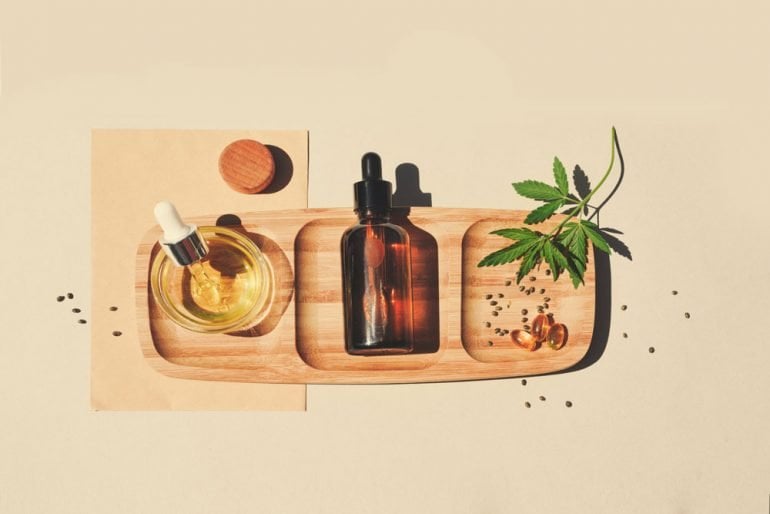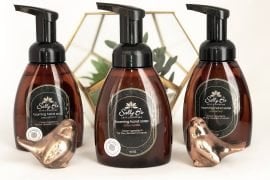Cannabidiol (CBD) is a compound whose popularity has skyrocketed over the last year. Despite its popularity, there are still many points consumers don’t fully understand about CBD. To help you make better purchasing choices, let’s take a look at three of the most common misconceptions about CBD.
1. CBD will make you “high” or test positive for cannabis on a drug test
Hemp plants are often CBD-rich. And while hemp is a member of the Cannabis sativa family, hemp plants contain less than 0.3% THC by dry weight. THC is short for Tetrahydrocannabinol, which is the primary compound in cannabis that gets you “high.”
The first misconception many people have when trying CBD is whether or not it will get them “high.”
So while your hemp plant may be cannabis it doesn’t have to contain noticeable levels of THC. This is a huge misconceptions about CBD.
It won’t get you “high” but it can effect your mood (for the better!)
That doesn’t mean CBD isn’t mind altering, however. CBD can exert a noticeable effect on mood that can vary depending on your tolerance to it. For some this may feel like a gentle relaxing effect. Others might feel significantly more relaxed, enough so to go to sleep. And for those with chronic pain conditions CBD’s analgesic properties can even feel like a “high” of its own. These are a few reasons why you may want to consider staying at home the first time you try CBD, or at least until you’re familiar with the way it affects you.
Now, about those drug tests…
Another one of the misconceptions about CBD is how it factors into drug tests. Will ingesting CBD cause someone to fail a drug test? It all depends on what type of CBD you’re consuming.
Full spectrum CBD means that all of the plant’s various compounds—cannabinoids, terpenes, flavonoids and more—are present in the final product. Full spectrum products typically contain small amounts of THC. Broad spectrum products contain all of the plant’s compounds except for THC. And isolate products are made with just that: pure, chemically isolated CBD.
If you’re solely ingesting CBD isolate products you’re not likely to fail a drug test. There is a very small chance that may happen with a full or broad spectrum product, however, so be sure to keep that in mind when shopping for CBD items.
2. CBD is “fish oil” or a scam (it can be)
Another one of the most prevalent negative beliefs about CBD is it is a marketing scam.
The degree to which this statement applies depends on the type of CBD products in question. A lack of federal regulation across the industry has meant that CBD manufacturers have had to self-regulate. And while that strategy seems to work for some, many brands haven’t upheld their end of the bargain when it comes to providing safe, quality products.
Make sure you read the labels
A 2017 research paper sought out to examine the accuracy of CBD labeling on products by analyzing 84 different samples. Researchers found 42.85% of products were under labeled, or contained more CBD than advertised. Another 26.19% were over labeled and had less CBD available than stated on the label. THC was also detected in 18 of the samples.
Another report published by the FDA in 2020 found that less than half of all products tested contained the amount of CBD on the label.
The FDA is making some cursory attempts to regulate such as sending warning letters to CBD companies for, “…illegally selling products containing cannabidiol (CBD) in ways that violate the Federal Food, Drug, and Cosmetic Act (FD&C Act).” But it’s by no means an adequate solution to an increasingly rampant problem.
CBD can exert therapeutic effects for select individuals—this much we know already. It’s the same reason why CBD is one of the main active ingredients in Sativex, an FDA-approved medication for treatment resistant epilepsy.
Are you using the right kind for you?
But CBD can only do so under the right conditions. CBD often works much better, for instance, when you use a full spectrum extract vs an isolate. Why’s that? Research shows us that CBD isolates often taper off, or stop providing additional benefit at a certain dose.
Full spectrum extracts, however, were shown to exert an increasingly dose dependent effect. They often will continue providing therapeutic properties even after the tapering off point of isolates. This suggests full spectrum extracts are ideal for those seeking to maximize the therapeutic effect of CBD.
Don’t forget about the “entourage effect”
CBD often also works better with other cannabinoids thanks to something called the Entourage Effect. This theory postulates the idea that cannabinoids work synergistically, which means combining CBD with other compounds like THC or CBG strengthens the effect.
The only way to know what you’re truly getting when you purchase CBD is to know how to read a product label well, and how to read a Certificate of Analysis. Ensuring you have a full spectrum extract that contains terpenes is a good way to identify if a CBD product may work best for you.
If a product doesn’t say it contains CBD but has other phrases like “hemp seed oil” as the ingredient, chances are it won’t do much of anything. This is one of those misconceptions about CBD that the industry doesn’t help with.
3. I tried it once and it didn’t work
The final misconception we’ll address here is the “one and done” effect. This phenomena happens when people consume CBD once and quickly exclaim “it didn’t work.”
There are so many reasons as to why this may be the case. A few of the most common ones include:
You didn’t take the right amount (dosage/potency)
Everybody responds differently to CBD. What may be large doses for some can seem small to others and vice versa. Just like with any other compound it makes sense that a failure to take the correct amount of CBD will fail to produce an adequate effect.
The only way you can ensure CBD works for you is to know what your “just right” dose is. This can be easily accomplished through titration. Titration is the process through which you take a dose of CBD, write down the dose, then monitor effects carefully. Write down how you feel, how long it took to get there and any other information you think may be important. You can then look through this data to get a sense for what your dose might be. The end goal is to find a dose where you can feel some of CBD’s therapeutic effects without negative side effects like drowsiness. And as always, consult your doctor before making any CBD-based decision.
Believe me, I’ve taken CBD for years — and learned a lot along the way.
You thought you took the right amount
My mother wondered why CBD wasn’t working for her for the longest time.
“How much CBD did you take?” I asked.
“¾ of a dropper,” she replied.
“Okay. So how many milligrams of CBD are in each dropper?”
*Cue silence*
My mom didn’t quite get the concept of how to figure out how much CBD was in each dropper, and I don’t blame her for that. Lots of companies make this much harder than it should be with busy or deceptive labeling practices.
Also Read: Here’s how to talk your grandmother into trying CBD.
Your product label should say how many milligrams of CBD are in each milliliter (for CBD oil, that is). Say the product you’re looking at contains 10 mg of CBD per ml of oil. If your ideal dose is 50 ml of CBD, so you’d need 5 full 1 mL droppers worth (5 ml of liquid) to get a full dose. That’s another one of the easily confused misconceptions about CBD.
You didn’t take it in the correct way
The final thing my mom got wrong about CBD was how to take it. She’d been swallowing the CBD with water and had wondered why it didn’t affect her.
The way you take CBD hugely affects how it’s metabolized. While practical, taking CBD as an edible, (i.e through eating a CBD-infused food like a gummy), often isn’t a very good way to consume CBD. Orally consumed CBD is subject to something called first pass metabolism where it undergoes additional breakdown in the digestive tract. In the end the amount of CBD absorbed from oral consumption is estimated to be between 13-19% based on animal studies.
You can improve the bioavailability of CBD by taking it sublingually, or by holding it under the tongue. Holding it under the tongue ensures CBD is absorbed through the capillaries in your mouth instead of having to be digested. You may need to keep CBD under the tongue for at least 30 seconds for it to take effect. But consult your doctor first starting or upping any CBD dose.
We hope this clears up some of the major misconceptions about CBD. As always, we’re here to help!

Janelle Lassalle is a writer and content creator that specializes in cannabis. She’s also an insanely passionate advocate and expert in all things CBD. You can find her work featured in a variety of publications such as Healthline, The Huffington Post, Leafly, Forbes, and High Times. Check out her portfolio, or follow her on Instagram @jenkhari.





